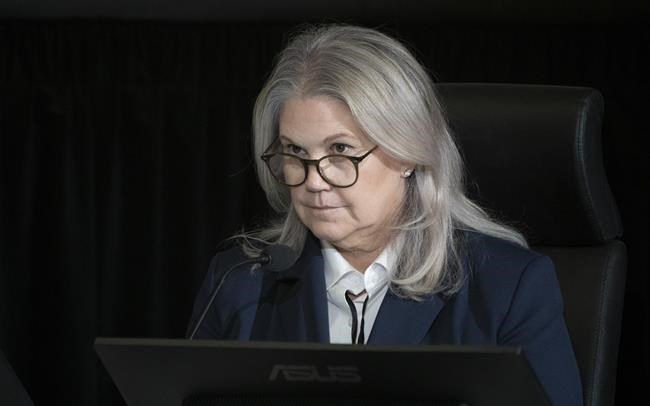OTTAWA — Prime Minister Justin Trudeau's national security adviser and other senior officials felt the Canadian Security Intelligence Service's threshold to determine a national threat under the Emergencies Act "should be reconsidered," a public inquiry has learned.
Jody Thomas told lawyers for the Public Order Emergency Commission, which is investigating the federal government's decision to invoke the act during the "Freedom Convoy" protests last winter, that in her opinion, the "totality of circumstances" at the time constituted a threat to national security, documents say.
She confirmed during testimony on Thursday that when cabinet met on Feb. 13 and ultimately decided to use the Emergencies Act, she was asked whether she thought it was necessary. She told them: "Yes."
And she contradicted earlier testimony from RCMP Commissioner Brenda Lucki, who told the inquiry earlier this week that she did not get a chance to convey a report during the Feb. 13 meeting that said police had not exhausted all the "tools" available to them in existing legislation.
"Individuals who are at that meeting are expected to provide information that is of use to decision-makers, being the prime minister and his cabinet," Thomas said. "And so if there's useful information or critical information, it needs to be provided whether you're on the speaking list or not."
Thomas also suggested that Lucki did not clearly communicate that police had updated operational plans to deal with the protest.
A document released by the inquiry containing a summary of an interview with Thomas and other officials suggests she was aware that CSIS had determined before that meeting that the protests did not meet the threshold of a national emergency, but she felt the agency's interpretation was too narrow.
The Emergencies Act relies on the CSIS Act's definition of "threats to the security of Canada" in its own definition of what constitutes a public order emergency. Under the CSIS Act, a threat would require a "known actor" to be engaging in violence or carrying out activities — and not just rhetoric — in support of a threat of serious violence.
The document said Thomas and her colleagues concluded that "security threats have evolved" since the act was passed in 1988, and the use of the definition "should be reconsidered."
Thomas added during her testimony that she believes officials were empowered to look more broadly than the definition in determining whether to invoke an emergency.
"Both acts were written in the 1980s and they both need to be modernized to reflect the reality of the nature of threats that are occurring in 2022," she said
The inquiry, which is mandated under the Emergencies Act, is set to continue its public hearings until Nov. 25 ahead of a final report early next year. It also heard on Thursday from top Department of Finance officials.
Documents show that Thomas was operating on information that mostly came from the Integrated Terrorism Assessment Centre and from open-source social media intelligence.
They also show that she did not receive direct reports from police involved in the response, including the Ontario Provincial Police, Ottawa Police Service and Windsor Police Service. She learned about arrests in Coutts, Alta., from the media instead of the RCMP.
There was an ongoing conversation among officials, Thomas said, over where the line was between a peaceful protest and a violent protest, and at what point intervention needed to happen. She said there were no firm conclusions made, and raised the spectre of the Jan. 6 events on Capitol Hill in the United States, suggesting that whether "Jan. 6 is about to happen" should not be the only factor.
"I don’t have an answer for it, but it is something that we have to consider as situations like this perhaps become more the norm," she said. "There is a spectrum of activity and behaviour and threat in there that we need to understand."
It appears there was confusion within the upper echelons of government over what the definition of "national security" even was in the Canadian context. There is no legal definition, a Privy Council Office official wrote in a Feb. 9 email to senior officials that outlined various definitions used in different parts of government.
Based on the definitions offered, the official who did the research, Philippe Lafortune, suggested: "I am of the opinion that downtown Ottawa may not constitute a national security issue, but border integrity could be."
By Feb. 11, three days before the act's invocation, protesters demonstrating against COVID-19 measures and the federal government had camped out on Ottawa's downtown streets for two weeks.
At that stage, Thomas said negotiating with protesters as a way to resolve the situation was still on the table.
But in a Feb. 12 cabinet meeting, she said Thursday, she advised that "it was not a workable plan."
She said it wasn't clear who the government could possibly negotiate with — given that, as the inquiry has heard, there was no specific leader — and who the government could even put in front of them. "There was not one group that had enough influence over the entire group to effect an outcome that could be positive."
Thomas also spoke about the difficulties national security officials had in determining whether violent threats were credible, since no federal agency had access to computer-based tools to analyze social media output.
To be determined as credible, a person must be identifiable, the threat must be specific and the person's ability to execute the threat must be determined.
"In the moment, in the middle of this crisis with the number of threats going up against elected officials, it was an enormous problem and an enormous concern," she said.
This report by The Canadian Press was first published Nov. 17, 2022.
David Fraser and Marie-Danielle Smith, The Canadian Press



